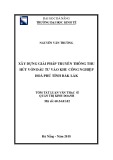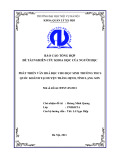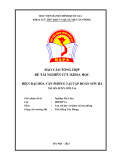
REVIEW Open Access
Oncogene addiction in gliomas: Implications for
molecular targeted therapy
Wei Yan
†
, Wei Zhang
†
and Tao Jiang
*
Abstract
Oncogene addiction is a phenomenon that the survival of cancer cells depends on an activated oncogene or
inactivation of tumor suppressor gene, and is regarded as the ‘Achilles heel’of the successful molecular targeted
therapies in cancer. However, the role of oncogene addiction in gliomas has not been elucidated systematically. In
this review, we summarize the current experimental and clinical evidence for the concept of oncogene addiction
and describe the mechanisms explaining oncogene addiction in gliomas. And the clinical implications for
oncogene addiction in molecular targeted therapy are further emphasized. In addition, we discuss future direction
for defining complex “oncogene addiction network”through the integrated analysis of multiple platforms in the
flow of genetic information in gliomagenesis.
Keywords: Oncogene addiction Glioma, Molecular targeted therapy, Network addiction
Introduction
Cancer arises as a result of a stepwise accumulation of
genetic aberrations [1]. Despite multiple genetic altera-
tions, its growth and survival can often be impaired by
the inactivation of a single oncogene. This phenomenon
indicates that tumors may become dependent upon a
single oncogenic activity for both maintenance of the
malignant phenotype and cell survival [2]. The phrase
“oncogene addiction”was coined by Bernard Weinstein
to describe the observation that tumor maintenance
often depends on the continued activity of certain onco-
gene or loss of tumor suppressor gene [3]. Oncogene
addiction provides a rationale for molecular targeted
therapy in cancers [4]. More and more researches pro-
posed that decoding of the oncogene addiction in cancer
may provide a key for effective cancer therapy. But it is
difficult to define oncogene addiction in numerous con-
ditions. And the efficacy of this strategy requires novel
methods, including integrative genomics and systems
biology, to identify the status of oncogene addiction in
individual cancer [3]. However, it has been known that
so many growth related pathways are activated in can-
cers. To date, it remains controversial whether the
cancer cells could get hooked on one single gene [5].
Although the debate that one gene shouldn’taffectit
much is still continuing, it is remarkable that in some
cases reversing only one of these genes can have a
strong inhibitory effect. Evidence that supports the con-
cept of oncogene addiction has been obtained in various
human cancers via Pubmed Search as indicated in Table
1[6-19].
Oncogene addiction in gliomas
Glioma is the most common primary brain tumor in
adults with poor prognosis [20]. The clinical outcomes
of patients with glioma traditionally depend upon the
tumor pathological grade. But the patients even within
the same grade usually have diverse prognosis and ther-
apeutic outcomes [21]. Over the last decade, the knowl-
edge on the molecular genetic background of human
gliomas has dramatically increased [22]. However, differ-
ences in glioma genetics may result in distinct prognosis
and therapeutic outcome, and the underlying mechan-
ism has not been clarified systematically. Underscoring
genetic aberrations in gliomas will enhance understand-
ing of tumor biology and have significant clinical rele-
vance for treatment. However, amounts of chromosomal
alterations and cancer-causing mutations have been dis-
covered through genome-scale approaches. The complex
genetic aberrations provide the basis for molecular
* Correspondence: taojiang1964@yahoo.com.cn
†Contributed equally
Department of Neurosurgery, Beijing Tiantan Hospital, Capital Medical
University, No.6 Tiantan Xili, Dongcheng District, Beijing 100050, China
Yan et al.Journal of Experimental & Clinical Cancer Research 2011, 30:58
http://www.jeccr.com/content/30/1/58
© 2011 Yan et al; licensee BioMed Central Ltd. This is an Open Access article distributed under the terms of the Creative Commons
Attribution License (http://creativecommons.org/licenses/by/2.0), which permits unrestricted use, distribution, and reproduction in
any medium, provided the original work is properly cited.

targeted therapies, and molecular tests serve to comple-
ment the subjective nature of histopathologic criteria
and add useful data regarding patient prognosis and
therapeutic outcome. Oncogene addiction hides in the
above background with complex genetic aberrations.
Different types of oncogene addiction can dictate dis-
tinct glioma subtypes. It becomes a promising direction
to define oncogene addiction for molecular targeted
therapy in gliomas. At present, only few oncogene
addictions have been identified in gliomas except for
E2F1 addiction [15], and some classical glioma-asso-
ciated genes may be potential oncogene addictions.
EGFR gene amplification or overexpression is a parti-
cularly striking feature of glioblastoma (GBM), observed
in approximately 40% of tumors. In nearly 50% of
tumors with EGFR amplification, a specific EGFR
mutant (EGFRvIII) can be detected [23]. This mutant is
highly oncogenic and is generated from a deletion of
exons2to7oftheEGFRgene,whichresultsinanin-
frame deletion of 267 amino acids from the extracellular
domain of the receptor. EGFRvIII is unable to bind
ligand, and it signals constitutively. Although EGFRvIII
has the same signaling domain as the wild-type receptor,
it seems to generate a distinct set of downstream signals
that may contribute to an increased tumorigenicity [24].
Targeted inhibition of EGFR activity can suppress signal
transduction pathways which control tumor cell growth,
proliferation, and resistance to apoptosis [25]. Small
molecule tyrosine kinase inhibitors and monoclonal
antibodies are among the most common EGFR targeting
agents and have been used clinically for treating various
malignancies [26]. Recently, it was reported that muta-
tions in the tyrosine kinase domain of EGFR gene can
predict the response to tyrosine kinase inhibitors [27].
And if alleles with EGFR mutations are amplified, the
response to tyrosine kinase inhibitors may differ relative
to mutant alleles without gene amplification [28]. Thus,
EGFR mutations enable the identification of the glioma
subgroup that is likely to be addicted to EGFRs.
Losses of chromosomes 1p and 19q are deemed corre-
lated with the diagnosis of oligodendroglioma, higher
PCV chemosensitivity and favorable prognosis [29]. The
average rates of 1p deletion and 1p/19q codeletion were
respectively 65.4 and 63.3% in oligodendrogliomas, 28.7
and 21.6% in oligoastrocytomas, 13.2 and 7.5% in astro-
cytomas, 11.6 and 2.9% in glioblastomas [30]. Estab-
lished indicators of the favorable outcome of
oligodendroglial tumors include LOH on chromosomes
1p and 19q, which may indicate a loss of function of as
yet unknown tumor-suppressor genes located in those
regions [31]. LOH of 1p in the heterogeneous popula-
tion of malignant gliomas may be one of the vital factors
besides MGMT promoter methylation that predict bet-
ter outcome in patients treated with TMZ [32].
Table 1 Oncogene addiction in various human cancers
Addicted oncogenes Implications in cancers Contributors
MYC Inactivation of MYC can result in dramatic and sustained tumor regression in
various cancers
Felsher et al., Genes Cancer. (2010) [6]
cyclin D1 Cell proliferation Lee et al., Cell Cycle. (2010) [7]
Met The MET tyrosine kinase stimulates cell scattering, invasion, protection from
apoptosis and angiogenesis
Comoglio et al., Nat Rev Drug Discov.
(2008) [8]
PDGFRA amplification
or mutation
Predictive biomarker of drug sensitivity Swanton et al., Cancer Biol Ther. (2009)
[9]
NF-kappaB Acquisition of resistance to CPT Togano et al., Biochem Biophys Res
Commun. (2009) [10]
FIP1L1-PDGFRalpha Generation sustained activation signaling to maintain a cell malignant
phenotype
Jin et al., Cancer Sci. (2009) [11]
PDGF-B PDGF-B is required to overcome cell-cell contact inhibition and to confer in
vivo infiltrating potential on tumor cells
Calzolari et al., Neoplasia. (2008) [12]
EGFR amplification or
mutations
Increased sensitivity to EGFR small molecule tyrosine kinase inhibitors Rothenberg et al., Proc Natl Acad Sci
USA. (2008) [13]
SphK1 SphK1 is involved in the major mechanisms underpinning oncogenesis Vadas et al., Biochim Biophys Acta.
(2008) [14]
E2F1 The E2F1 protein functions as a transcription factor that enhances cell
proliferation
Alonso et al., Cancer Lett. (2008)
[15]
HSP90 Cell proliferation and/or survival Workman et al., Ann N Y Acad Sci.
(2007) [16]
Bcr-Abl Chemosensitivity to imatinib Chen et al., Cancer Res. (2006) [17]
mTOR mTOR plays a central role in cell growth, proliferation and survival Choo et al., Cancer Cell. (2006) [18]
microRNA-21 Overexpression of miR-21 leads to a pre-B malignant lymphoid-like phenotype Medina et al., Nature. (2010) [19]
Yan et al.Journal of Experimental & Clinical Cancer Research 2011, 30:58
http://www.jeccr.com/content/30/1/58
Page 2 of 5

Mutations in IDH1/2 are a common feature of a
major subset of primary human brain tumors [33].
Recent studies reported that mutations usually affected
amino acid 132 of IDH1 in more than 70% of grade II-
III gliomas and secondary glioblastomas. Tumors with-
out mutations in IDH1 often had mutations affecting
the analogous amino acid (R172) of the IDH2 gene.
Tumors with IDH1 or IDH2 mutations had distinctive
genetic and clinical characteristics, and patients with
such tumors had a better outcome than those with
wild-type IDH genes [34,35]. IDH1 mutation contributes
to tumorigenesis partly through induction of the HIF-1
pathway [36]. And it has been recently reported that
tumor-derived IDH1 and IDH2 mutations reduced a-
KG and accumulated a a-KG antagonist, 2-hydroxyglu-
tarate (2-HG), leading to genome-wide histone and
DNA methylation alterations [37]. 2-HG accumulation
caused by IDH mutation was also reported to be
involved in the formation of malignant gliomas [38]. A
recent study has demonstrated that IDH mutation was
correlated with a higher rate of response to temozolo-
mide and appeared to be a significant marker of positive
prognosis in low-grade gliomas [39]. Taken together,
mutations in IDH genes seem to arise from a common
glial precursor and play an important role in the forma-
tion of specific glioma subtype in which IDH1/2 muta-
tion functions as oncogene addiction.
MicroRNAs (miRNAs) belong to a recently discovered
class of small non-coding RNA molecules that regulate
the expression of multiple target genes. Some miRNAs,
referred to as oncomiRs, show differential expression
levels in cancer and are able to affect cellular transforma-
tion, carcinogenesis and metastasis, acting either as onco-
genes or tumour suppressors. Oncogene addiction to
oncomiRs has been proposed in several human cancers
[19,40,41]. A lot of studied showed that the aberrant
expression miRNAs, including miR-21, miR-221/222,
miR-181s and miR-34s, played an important role in glio-
magenesis [42-45]. Overexpression of miR-21 could lead
to a malignant phenotype, demonstrating that mir-21
was a genuine oncogene. When miR-21 was inactivated,
the tumours regressed completely in a few days, partly as
a result of apoptosis [42]. And miR-181a and 181b func-
tioned as tumor suppressors in glioma cells [44]. These
results demonstrate that tumors could become addicted
to oncomiRs and support efforts in treating human can-
cers through pharmacological inactivation of miRNAs
such as miR-21 or upregulation of miR-181s.
Clinical implications of oncogene addiction in
molecular targeted therapy for gliomas
Chemotherapeutic agent therapy or molecular targeted
therapy always works in tumors with certain respective
genetic background. A growing body of genetic
aberrations was identified in gliomas, only a subset of
genes acting as drivers in carcinogenesis can be recog-
nized as oncogene addition. Meanwhile, most genes just
act as downstream effectors of addicted oncogenes.
Oncogene addiction is an ideal potential target for
molecular targeted therapy in human cancers. Therapies
targeting genes causally linked to carcinogenesis have
been successful in a subset of tumor types [46]. Each
subtypeofgliomasmaydisplayadifferentoncogene
addiction. Some molecular targeted drugs only work in
a subgroup of tumor patients. The choice of the appro-
priate molecular targeted agent and combination ther-
apy for a specific patient with cancer is largely
empirical. In theory, it is essential to define specific
oncogene addiction for individuals before choosing
molecular targeted drugs. It should be pointed out that
distinct kinds of cells in one sample (e.g. CD133- and
CD133+ cells) have different oncogene addictions due
to the heterogeneity of glioma. Thus combination of
multiple drugs is required to target more than one
oncogene addictions in one patient. In addition, onco-
gene addiction is always moving as the therapeutic tar-
gets in gliomas. After exposure to therapeutic agents,
cancer cells can escape from one established oncogene
addition to another. At this situation, previous drugs
would not work anymore. This may be the reason of
acquired drug resistance. We named the above phenom-
enon to “Oncogene addiction transition”. Studies are
needed for further investigating possible direction of
oncogene addiction transition, which is important for
choosing rational scheme of combination therapy. Tar-
geting the existing oncogene addiction in combination
with blocking the direction of oncogene addiction tran-
sition may effectively suppress the growth of glioma
cells. Defining oncogene addiction and direction of
potential transition in advance based on gene expression
profile and bioinformatics analysis will be the novel
orientation of combination therapy in the future.
Approaches for defining oncogene addiction
Recently, the utilities of fluorescence in situ hybridization
(FISH), DNA sequencing and methylation specific-poly-
merase chain reaction (MS-PCR), are widely being
employed in assessment of several genetic aberrations for
human gliomas [47]. However, it has been reported that
systematic characterization of cancer genome has revealed
diverse aberrations among different individuals, such that
the functional significance and physiological consequence
of most genetic alterations remain poorly defined [48].
Cancer cells are characterized by acquired functional cap-
abilities: self-sufficiency in exogenous growth signals,
insensitivity to antigrowth signals, limitless replicative
potential, evasion of apoptosis, sustained angiogenesis, and
acquisition of invasiveness and metastatic ability. The
Yan et al.Journal of Experimental & Clinical Cancer Research 2011, 30:58
http://www.jeccr.com/content/30/1/58
Page 3 of 5

order and mechanistic means to achieve these properties
can vary between different tumors. Therefore, cancers are
always complex, involving an interplay between various
genes and a number of critical pathways and signaling cas-
cades, and the detection of only a single marker molecule
is usually insufficient for determining oncogene addiction
in gliomas. However, the possibility of developing novel
selective drugs against such a large number of genetic
aberrations seems extremely daunting. It has been also
reported that genetic lesions in cancers tend to cluster
around certain pathways, suggesting the concept of ‘net-
work addiction’,ratherthan‘oncogene addiction’[46]. It is
very difficult to define certain driver genes from amounts
of passenger genes in gliomas. Due to the limitation of a
single gene or signaling pathway in identifying molecular
pattern and predicting clinical prognosis of gliomas, high-
throughput screening oncogene addiction networks was
highlighted. A lot of single platform analysis cannot iden-
tify novel molecular markers that can apply to clinical
practice. The integrated analysis of multiple platforms in
the flow of genetic information may provide a promising
direction for defining oncogene addiction networks.
Advances in whole-genome microarray techniques are
providing unprecedented opportunities for comprehensive
analysis of multi-platform genetic information. The inte-
gration of these data sets with genetic aberrations and
clinical informations will define novel oncogene addiction
networks based on the individual genomics of the patients
with glioma. A recent study has showed that a computa-
tional approach that integrates chromosomal copy number
and gene expression data for detecting aberrations that
promote cancer progression [48]. And software has been
also developed to identify cancer driver genes in whole-
genome sequencing studies [49]. Oncogene addiction net-
works will likely provide a valuable frame for designing
combination therapy of molecular targeted drugs in future.
Conclusion
Developing novel approaches for defining oncogene
addiction networks, coupled with specific combination
of molecular targeted agents, will make it possible to
achieve more effective and personalized molecular tar-
geted therapy in human gliomas.
Author details
1
Department of Neurosurgery, Beijing Tiantan Hospital,
Capital Medical University, No.6 Tiantan Xili, Dong-
cheng District, Beijing 100050, China.
Abbreviations
MiRNAs: MicroRNAs; LOH: Loss of heterozygosity; FISH: fluorescence in situ
hybridization; MS-PCR: methylation specific-polymerase chain reaction.
Acknowledgements
This work was supported by grants from National Key Project of Science and
Technology Supporting Programs (No. 2007BAI05B08) and National Natural
Science Foundation of China (No. 30772238 and 30730035).
Authors’contributions
TJ initiated the concept. WY and WZ drafted the manuscript. All authors
participated in writing, read and approved the final manuscript. WY and WZ
contributed equally to this article.
Competing interests
The authors declare that they have no competing interests.
Received: 12 March 2011 Accepted: 17 May 2011
Published: 17 May 2011
References
1. Mizuarai S, Irie H, Schmatz DM, Kotani H: Integrated genomic and
pharmacological approaches to identify synthetic lethal genes as cancer
therapeutic targets. Curr Mol Med 2008, 8:774-783.
2. Weinstein IB, Joe AK: Mechanisms of disease: Oncogene addiction–a
rationale for molecular targeting in cancer therapy. Nat Clin Pract Oncol
2006, 3:448-457.
3. Weinstein IB, Joe A: Oncogene addiction. Cancer Res 2008, 68:3077-3080.
4. Weinstein IB: Cancer: Addiction to oncogenes–the Achilles heal of
cancer. Science 2002, 297:63-64.
5. Garber K: New insights into oncogene addiction found. J Natl Cancer Inst
2007, 99:264-265, 269.
6. Felsher DW: MYC Inactivation Elicits Oncogene Addiction through Both
Tumor Cell-Intrinsic and Host-Dependent Mechanisms. Genes Cancer
2010, 1:597-604.
7. Lee JT, Shan J, Gu W: Targeting the degradation of cyclin D1 will help to
eliminate oncogene addiction. Cell Cycle 2010, 9:857-858.
8. Comoglio PM, Giordano S, Trusolino L: Drug development of MET
inhibitors: targeting oncogene addiction and expedience. Nat Rev Drug
Discov 2008, 7:504-516.
9. Swanton C, Burrell RA: Advances in personalized therapeutics in non-
small cell lung cancer: 4q12 amplification, PDGFRA oncogene addiction
and sunitinib sensitivity. Cancer Biol Ther 2009, 8:2051-2053.
10. Togano T, Sasaki M, Watanabe M, Nakashima M, Tsuruo T, Umezawa K,
Higashihara M, Watanabe T, Horie R: Induction of oncogene addiction
shift to NF-kappaB by camptothecin in solid tumor cells. Biochem Biophys
Res Commun 2009, 390:60-64.
11. Jin Y, Chen Q, Lu Z, Chen B, Pan J: Triptolide abrogates oncogene FIP1L1-
PDGFRalpha addiction and induces apoptosis in hypereosinophilic
syndrome. Cancer Sci 2009, 100:2210-2217.
12. Calzolari F, Appolloni I, Tutucci E, Caviglia S, Terrile M, Corte G, Malatesta P:
Tumor progression and oncogene addiction in a PDGF-B-induced model
of gliomagenesis. Neoplasia 2008, 10:1373-1382, following 1382..
13. Rothenberg SM, Engelman JA, Le S, Riese DJ, Haber DA, Settleman J:
Modeling oncogene addiction using RNA interference. Proc Natl Acad Sci
USA 2008, 105:12480-12484.
14. Vadas M, Xia P, McCaughan G, Gamble J: The role of sphingosine kinase 1
in cancer: oncogene or non-oncogene addiction? Biochim Biophys Acta
2008, 1781:442-447.
15. Alonso MM, Alemany R, Fueyo J, Gomez-Manzano C: E2F1 in gliomas: a
paradigm of oncogene addiction. Cancer Lett 2008, 263:157-163.
16. Workman P, Burrows F, Neckers L, Rosen N: Drugging the cancer
chaperone HSP90: combinatorial therapeutic exploitation of oncogene
addiction and tumor stress. Ann N Y Acad Sci 2007, 1113:202-216.
17. Chen R, Gandhi V, Plunkett W: A sequential blockade strategy for the
design of combination therapies to overcome oncogene addiction in
chronic myelogenous leukemia. Cancer Res 2006, 66:10959-10966.
18. Choo AY, Blenis J: TORgeting oncogene addiction for cancer therapy.
Cancer Cell 2006, 9:77-79.
19. Medina PP, Nolde M, Slack FJ: OncomiR addiction in an in vivo model of
microRNA-21-induced pre-B-cell lymphoma. Nature 2010, 467:86-90.
20. Minniti G, Muni R, Lanzetta G, Marchetti P, Enrici RM: Chemotherapy for
glioblastoma: current treatment and future perspectives for cytotoxic
and targeted agents. Anticancer Res 2009, 29:5171-5184.
Yan et al.Journal of Experimental & Clinical Cancer Research 2011, 30:58
http://www.jeccr.com/content/30/1/58
Page 4 of 5

21. van den Bent MJ, Kros JM: Predictive and prognostic markers in neuro-
oncology. J Neuropathol Exp Neurol 2007, 66:1074-1081.
22. Eoli M, Silvani A, Pollo B, Bianchessi D, Menghi F, Valletta L, Broggi G,
Boiardi A, Bruzzone MG, Finocchiaro G: Molecular markers of gliomas: a
clinical approach. Neurol Res 2006, 28:538-541.
23. Hatanpaa KJ, Burma S, Zhao D, Habib AA: Epidermal growth factor
receptor in glioma: signal transduction, neuropathology, imaging, and
radioresistance. Neoplasia 2010, 12:675-684.
24. Gan HK, Kaye AH, Luwor RB: The EGFRvIII variant in glioblastoma
multiforme. J Clin Neurosci 2009, 16:748-754.
25. Wykosky J, Fenton T, Furnari F, Cavenee WK: Therapeutic targeting of
epidermal growth factor receptor in human cancer: successes and
limitations. Chin J Cancer 2011, 30:5-12.
26. Butowski N, Chang SM: Small molecule and monoclonal antibody
therapies in neurooncology. Cancer Control 2005, 12:116-124.
27. Gazdar AF: Activating and resistance mutations of EGFR in non-small-cell
lung cancer: role in clinical response to EGFR tyrosine kinase inhibitors.
Oncogene 2009, 28:S24-S31.
28. Benito R, Gil-Benso R, Quilis V, Perez M, Gregori-Romero M, Roldan P,
Gonzalez-Darder J, Cerdá-Nicolas M, Lopez-Gines C: Primary glioblastomas
with and without EGFR amplification: relationship to genetic alterations
and clinicopathological features. Neuropathology 2010, 30:392-400.
29. Kreiger PA, Okada Y, Simon S, Rorke LB, Louis DN, Golden JA: Losses of
chromosomes 1p and 19q are rare in pediatric oligodendrogliomas. Acta
Neuropathol 2005, 109:387-392.
30. Fontaine D, Vandenbos F, Lebrun C, Paquis V, Frenay M: Diagnostic and
prognostic values of 1p and 19q deletions in adult gliomas: critical
review of the literature and implications in daily clinical practice. Rev
Neurol (Paris) 2008, 164:595-604.
31. Ramirez C, Bowman C, Maurage CA, Dubois F, Blond S, Porchet N,
Escande F: Loss of 1p, 19q, and 10q heterozygosity prospectively
predicts prognosis of oligodendroglial tumors–towards individualized
tumor treatment? Neuro Oncol 2010, 12:490-499.
32. Ishii D, Natsume A, Wakabayashi T, Hatano H, Asano Y, Takeuchi H,
Shimato S, Ito M, Fujii M, Yoshida J: Efficacy of temozolomide is correlated
with 1p loss and methylation of the deoxyribonucleic acid repair gene
MGMT in malignant gliomas. Neurol Med Chir (Tokyo) 2007, 47:341-349,
discussion 350..
33. Dang L, White DW, Gross S, Bennett BD, Bittinger MA, Driggers EM,
Fantin VR, Jang HG, Jin S, Keenan MC, et al:Cancer-associated IDH1
mutations produce 2-hydroxyglutarate. Nature 2009, 462:739-744.
34. Yan H, Parsons DW, Jin G, McLendon R, Rasheed BA, Yuan W, Kos I, Batinic-
Haberle I, Jones S, Riggins GJ, et al:IDH1 and IDH2 mutations in gliomas.
N Engl J Med 2009, 360:765-773.
35. Balss J, Meyer J, Mueller W, Korshunov A, Hartmann C, von Deimling A:
Analysis of the IDH1 codon 132 mutation in brain tumors. Acta
Neuropathol 2008, 116:597-602.
36. Zhao S, Lin Y, Xu W, Jiang W, Zha Z, Wang P, Yu W, Li Z, Gong L, Peng Y,
et al:Glioma-derived mutations in IDH1 dominantly inhibit IDH1
catalytic activity and induce HIF-1alpha. Science 2009, 324:261-265.
37. Xu W, Yang H, Liu Y, Yang Y, Wang P, Kim SH, Ito S, Yang C, Wang P,
Xiao MT, et al:Oncometabolite 2-hydroxyglutarate is a competitive
inhibitor of α-ketoglutarate-dependent dioxygenases. Cancer Cell 2011,
19:17-30.
38. Sonoda Y, Tominaga T: 2-hydroxyglutarate accumulation caused by IDH
mutation is involved in the formation of malignant gliomas. Expert Rev
Neurother 2010, 10:487-489.
39. Houillier C, Wang X, Kaloshi G, Mokhtari K, Guillevin R, Laffaire J, Paris S,
Boisselier B, Idbaih A, Laigle-Donadey F, et al:IDH1 or IDH2 mutations
predict longer survival and response to temozolomide in low-grade
gliomas. Neurology 2010, 75:1560-1566.
40. Matsubara H, Takeuchi T, Nishikawa E, Yanagisawa K, Hayashita Y, Ebi H,
Yamada H, Suzuki M, Nagino M, Nimura Y, et al:Apoptosis induction by
antisense oligonucleotides against miR-17-5p and miR-20a in lung
cancers overexpressing miR-17-92. Oncogene 2007, 26:6099-6105.
41. Jeang KT: Human T cell leukemia virus type 1 (HTLV-1) and oncogene or
oncomiR addiction? Oncotarget 2010, 1:453-456.
42. Moore LM, Zhang W: Targeting miR-21 in glioma: a small RNA with big
potential. Expert Opin Ther Targets 2010, 14:1247-1257.
43. Zhang CZ, Zhang JX, Zhang AL, Shi ZD, Han L, Jia ZF, Yang WD, Wang GX,
Jiang T, You YP, et al:MiR-221 and miR-222 target PUMA to induce cell
survival in glioblastoma. Mol Cancer 2010, 9:229.
44. Shi L, Cheng Z, Zhang J, Li R, Zhao P, Fu Z, You Y: hsa-mir-181a and hsa-
mir-181b function as tumor suppressors in human glioma cells. Brain Res
2008, 1236:185-193.
45. Li Y, Guessous F, Zhang Y, Dipierro C, Kefas B, Johnson E, Marcinkiewicz L,
Jiang J, Yang Y, Schmittgen TD, et al:MicroRNA-34a inhibits glioblastoma
growth by targeting multiple oncogenes. Cancer Res 2009, 69:7569-7576.
46. Tonon G: From oncogene to network addiction: the new frontier of
cancer genomics and therapeutics. Future Oncol 2008, 4:569-577.
47. Eoli M, Silvani A, Pollo B, Bianchessi D, Menghi F, Valletta L, Broggi G,
Boiardi A, Bruzzone MG, Finocchiaro G: Molecular markers of gliomas: a
clinical approach. Neurol Res 2006, 28:538-541.
48. Akavia UD, Litvin O, Kim J, Sanchez-Garcia F, Kotliar D, Causton HC,
Pochanard P, Mozes E, Garraway LA, Pe’er D: An integrated approach to
uncover drivers of cancer. Cell 2010, 143:1005-1017.
49. Youn A, Simon R: Identifying cancer driver genes in tumor genome
sequencing studies. Bioinformatics 2011, 27:175-181.
doi:10.1186/1756-9966-30-58
Cite this article as: Yan et al.: Oncogene addiction in gliomas:
Implications for molecular targeted therapy. Journal of Experimental &
Clinical Cancer Research 2011 30:58.
Submit your next manuscript to BioMed Central
and take full advantage of:
• Convenient online submission
• Thorough peer review
• No space constraints or color figure charges
• Immediate publication on acceptance
• Inclusion in PubMed, CAS, Scopus and Google Scholar
• Research which is freely available for redistribution
Submit your manuscript at
www.biomedcentral.com/submit
Yan et al.Journal of Experimental & Clinical Cancer Research 2011, 30:58
http://www.jeccr.com/content/30/1/58
Page 5 of 5




![PET/CT trong ung thư phổi: Báo cáo [Năm]](https://cdn.tailieu.vn/images/document/thumbnail/2024/20240705/sanhobien01/135x160/8121720150427.jpg)











![Báo cáo seminar chuyên ngành Công nghệ hóa học và thực phẩm [Mới nhất]](https://cdn.tailieu.vn/images/document/thumbnail/2025/20250711/hienkelvinzoi@gmail.com/135x160/47051752458701.jpg)









